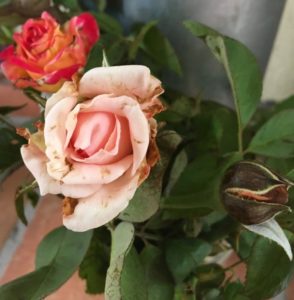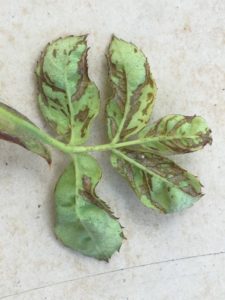Frank Brines
Rose Care FUNdamentals – August 2022

Frank Brines
ARS Master Rosarian
Summer is certainly upon us—and based on past experience, it’s only going to get hotter before it gets cooler. (I didn’t need to tell you that at the beginning of August, did I?) 2022 is and has been very unusual weather wise breaking records all over the globe.
Since high summer temperatures and less-than-ideal conditions for roses are inevitable for the next couple of months, let’s get ready! Stroll through your gardens in the AM, look for leaf wilt, drying or discoloring of leaves and the general leaf reflectance (surface luster). If it appears dull, investigate the plant for disease, drought or pests. If you’ve taken my advice, you’re letting your roses continue their summer dormancy until about mid-September. Struggling to remain hydrated will likely produce poor quality blooms. Just remove and discard the withered petals and let the hips develop, keep the bed clean of debris, and DON’T fertilize. Be sure your irrigation program is in good condition and delivering needed water. It doesn’t take long for a rose to suffer once its irrigation supply fails.
When temperatures range in the 90* zone roses like most living things perspire which requires intake of more water to keep cool and live. Roses “perspire” through cells along the edge of the leaf. If there is not sufficient moisture in the root zone browning of the leaves result. This is the sign of heat stress and needs immediate attention. This situation also limits bloom size, color and appearance of burned crinkled petals. This is why as much as 12 gallons of water per week in needed for the rose just to survive let alone produce lovely beautiful blooms. I suggest only removing the petals of any roses that bloom and any fallen debris. Do not fertilize and increase the water. Let the plant rest the best it can. In the event that foliage becomes so stressed from heat and turns brown, dead falls off be careful not to remove so much that the cane becomes unprotected from the sun and get sunburned which could kill the plant.
Chilli Thrips are a year-round pest but they love hot summer days best. They are 0.016 – 0.024 inch long, one fourth the size of the Western Flower Thrip. You’ll know Chilli Thrips are present only when new foliage and blooms are already damaged. Blooms will be deformed, discolored and outer petals will be darkened (Image 1). Buds will be distorted, darkened and may not open (Image 2). You’ll notice misshapen distorted new foliage and bronzing on back of new leaves (Image 3).
Chilli Thrips love ALL new foliage and bloom colors, unlike Western Flower Thrips who prefer light colors. It’s astounding the amount of damage they can do in a very short time. Control is easiest in the earliest stages since a severe infestation can rapidly defoliate a rose bush AND your other plants too. During hot weather the life cycle for Chilli Thrips is 11 days. Part of that time is spent in soil or debris under the plants. The larvae stage molt into a pupal stage and usually enter the soil or debris to eventually emerge as adults. Only the larvae and adults are feeding stages. Adults are dispersed by wind over long distances.
Integrated pest management stresses the importance of cultural, mechanical and biological controls before resorting to the least toxic chemical control. Since Chilli Thrips have a short life cycle (11 days) you must detect damage and implement a method of control immediately. Cut out damaged buds, blooms and leaves; remove all fallen leaves and petals from garden. A natural hero in the fight is the minute pirate bug which feast on all stages of this pest, as well as on spider mites, insect eggs, aphids, and small caterpillars. You can actually buy them on the internet!
If chemical control becomes needed choose the least toxic spray and follow label directions. During infestation all new growth will need to be sprayed weekly. Conserve or Captain Jack’s Deadbug Brew concentrate are two organic sprays with active ingredient Spinosad. Spinosad will not harm ladybugs, green lacewings, pirate bugs or predatory mites. Spray early in morning or in evening after bees are less likely to be active and before temperatures reach the 80*s.
During your daily tour of your garden look for any changes. Examine the lower leaves. If they appear yellow or brown, have fine webbing and/or look dirty, there may be an infestation of spider mites. Some areas have experienced a real problem with spider mites this year. They thrive in hot weather. They’re generally found on the undersides of those leaves. A quick check can be made by lightly running your fingers across the underside of the leaf. If it has a small grainy feel it most likely is the spider mite. A strong spray of water from below followed by an overhead shower should take care of the problem or, at least, hold it in check. Give the shower early in the day so the plant has time to dry before the sun becomes hot. Do this every 3 days for 10-14 days, inspecting regularly. It may be necessary to repeat after a few days if the infestation is heavy. Captain Jack’s Deadbug Brew is good product to use in this case. Removing the bottom leaves approximately 8” from soil level can help in reducing or eliminating the spider mite problem. This should be done earlier, prior to an infestation.
The world is dangerous enough for plants, but we gardeners are also faced with risks. One is a dangerous fungus with the scientific name Sporothrix schenckii. It afflicts humans with the fungus infection sporotrichosis which is often referred to as the Rose Thorn (or Rose Gardener’s) Disease. The fungus resides on hay, sphagnum moss, the tips of rose thorns and in soil. It can cause infection, redness, swelling and open ulcers at the puncture site. The fungus can also spread to the lymphatic system and move on to the joints and bones where it ends up attacking the central nervous system and lungs when the thorn or thorns are deeply embedded. A relatively uncommon condition, diagnosis can be complicated. Physicians often mistake it as Staph or Strep infection. Be sure to inform your physician that you are a gardener so appropriate diagnosis and treatment are rendered.





